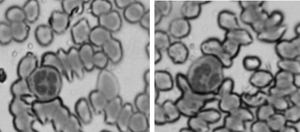Published online by Cambridge University Press: 02 August 2021

Methods based on the evaluation of textural patterns in microscopy, such as the “gray-level co-occurrence matrix” (GLCM) analysis are modern and innovative computer and mathematical algorithms that can be used to quantify subtle structural changes in cells and their organelles. Potential application of GLCM method in the fields of psychophysiology and psychiatry to this date has not been systematically investigated. The main objective of our study was to test the existence and strength of the association between chromatin structural organization of peripheral blood neutrophils and levels of self-perceived mental stress. The research was done on a sample of 100 healthy student athletes, and the Depression, Anxiety, and Stress Scales (DASS-21) were used for the estimation of psychological distress. Chromatin textural homogeneity and uniformity were negatively correlated (p < 0.01) with mental distress and had relatively good discriminatory power in differentiating participants with normal and elevated stress levels. As an addition, we propose the creation of a machine learning model based on binomial logistic regression that uses these and other GLCM features to predict stress elevation. To the best of our knowledge, these results are one of the first to establish the link between neutrophil chromatin structural organization quantified by the GLCM method and indicators of normal psychological functioning.